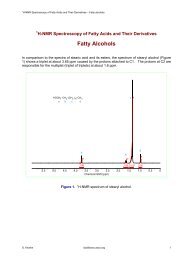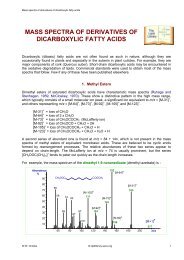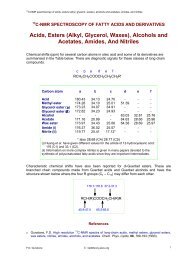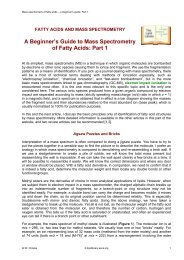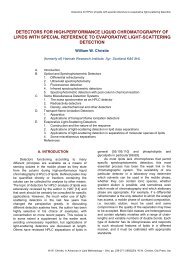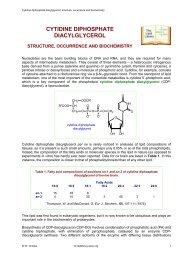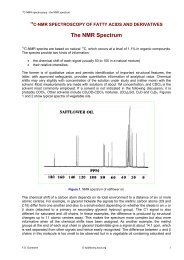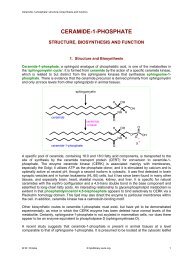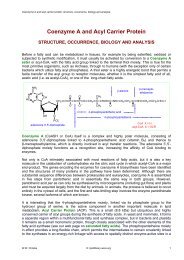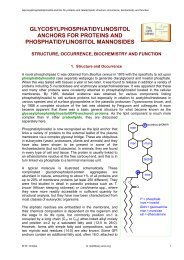Plant oxylipins: chemistry and biology - Lipid Library
Plant oxylipins: chemistry and biology - Lipid Library
Plant oxylipins: chemistry and biology - Lipid Library
Create successful ePaper yourself
Turn your PDF publications into a flip-book with our unique Google optimized e-Paper software.
<strong>Plant</strong> <strong>oxylipins</strong>: <strong>chemistry</strong> <strong>and</strong> <strong>biology</strong><br />
PLANT OXYLIPINS<br />
Chemistry <strong>and</strong> Biology<br />
1. Introduction<br />
<strong>Plant</strong>s lack an immune system in the sense that it exists in animals, but they possess mechanisms<br />
that recognize potential pathogens <strong>and</strong> initiate defense responses. It has become evident that<br />
various types of oxygenated fatty acids, collectively termed ‘<strong>oxylipins</strong>’ or sometimes<br />
‘octadecanoids’, are involved in responses to physical damage by animals or insects, stress <strong>and</strong><br />
attack by pathogens. These compounds are similar in many ways to the eicosanoids derived from<br />
arachidonate in animals, which have so many varied functions but especially in the inflammatory<br />
process.<br />
There are very few definitive reports of the presence of arachidonic acid in higher plants, <strong>and</strong><br />
<strong>oxylipins</strong> are derived from linoleic <strong>and</strong> more importantly α-linolenic acid, released from their lipid<br />
associations by poorly defined acyl hydrolases (lipases) of various kinds. A brief discussion of the<br />
various enzymes involved follows, <strong>and</strong> more detailed information is available elsewhere on this<br />
website. A first key step in oxidation is the action of lipoxygenases, although cytochrome P450 <strong>and</strong><br />
pathogen-induced oxygenases have lesser roles. For example, depending on the source of the<br />
enzyme, lipoxygenases (EC 1.13.11.12) (LOX) catalyses the oxidation of α-linolenic acid into either<br />
9- or 13-hydroperoxy-octadecatrienoic acids, or a mixture of both. Such compounds are highly<br />
reactive, <strong>and</strong> they are quickly metabolized by various enzymes into series of <strong>oxylipins</strong>, as<br />
summarized in the figure below, with a range of distinct biological activities.<br />
a<br />
αDOX<br />
2-hydroperoxy FA<br />
aldehydes<br />
jasmonates<br />
AOS<br />
epoxy-hydroxy-<br />
FA<br />
EAS<br />
keto-FA<br />
18:2 or 18:3<br />
LOX<br />
HPL<br />
LOX<br />
9- or 13-hydroperoxides<br />
POX<br />
leaf aldehydes<br />
leaf alcohols<br />
traumatin<br />
reductase<br />
DES<br />
epoxy-hydroxy-<br />
FA<br />
a<br />
LOX = lipoxygenase<br />
DES = divinylether synthase<br />
POX = peroxygenase<br />
HPL = hydroperoxide lyase<br />
EAS = epoxy alcohol synthase<br />
AOS = allene oxide synthase<br />
αDOX = α-dioxygenase<br />
hydroxy-FA<br />
divinylether<br />
FA<br />
W.W. Christie © lipidlibrary.aocs.org 1
<strong>Plant</strong> <strong>oxylipins</strong>: <strong>chemistry</strong> <strong>and</strong> <strong>biology</strong><br />
An alternative oxidation reaction utilizes an α-dioxygenase, distinct from the lipoxygenases, to<br />
generate 2-hydroperoxy fatty acids, which decay spontaneously to produce an aldehyde one<br />
carbon atom shorter, as part of the α-oxidation process in plants.<br />
2. Lipoxygenases<br />
Lipoxygenases are non-heme iron-containing dioxygenases that are widely distributed in plants<br />
<strong>and</strong> animals. That from soybean was among the first to be studied in great detail, including its<br />
three-dimensional structure, <strong>and</strong> the knowledge gained assisted greatly with the underst<strong>and</strong>ing of<br />
the analogous animal enzymes. <strong>Plant</strong> LOX consist of a single polypeptide chain with a molecular<br />
mass of 94 to 104 kDA. The carboxy-terminal domain harbors the catalytic site of the enzyme,<br />
which contains a non-heme iron atom that is coordinated with five amino acids - three histidines,<br />
one asparagine <strong>and</strong> the carboxyl group of the carboxy-terminal isoleucine. The amino-terminal<br />
domain may be involved in membrane or substrate binding.<br />
From amino acid-sequence studies of enzymes from a number of plant sources, it is evident that<br />
there are two main families of lipoxygenases, designated ‘type-1’ (mainly extra-plastidial) <strong>and</strong><br />
‘type-2’ (mainly plastidial), but many different iso-enzymes exist depending on the particular<br />
species. Soybean lipoxygenase exists in eight different isoforms, for example. They include both<br />
soluble cytoplasmic <strong>and</strong> membrane-bound enzymes. In Arabidopsis, lipoxygenase activity is<br />
located mainly in the plastidial envelope <strong>and</strong> stroma of leaf chloroplasts. There are suggestions<br />
that isoforms in different subcellular regions may provide different pools of hydroperoxy fatty acids,<br />
which serve as substrates for alternative metabolic pathways <strong>and</strong> physiological functions. The<br />
properties of lipoxygenases in general are discussed in the Introductory web page. Here, those<br />
properties characteristic of the plant enzymes are discussed.<br />
Lipoxygenases catalyse the addition of molecular oxygen to polyunsaturated fatty acids containing<br />
a (cis,cis)-1,4-pentadiene system to yield an unsaturated fatty acid hydroperoxide. Oxygen can be<br />
added to either end of the pentadiene system with high stereospecificity, <strong>and</strong> in the case of linoleic<br />
<strong>and</strong> α-linolenic acids, this leads to either the 9(S)- or 13(S)-hydroperoxy derivatives or both<br />
depending on the specific iso-form of the enzyme. For example, the model plant Arabidopsis<br />
contains two genes encoding for 9-LOXs <strong>and</strong> four that encode 13-LOXs. Physiological conditions<br />
can also affect this positional specificity (regiospecificity), <strong>and</strong> under conditions of low oxygen<br />
concentrations, for example, the soybean LOX-1 produces equal amounts of the two isomers,<br />
though normally the 13(S) isomer predominates. Photosynthetic tissues tend to produce mainly<br />
13(S)-hydroperoxides.<br />
a<br />
OOH<br />
13<br />
13(S)-hydroperoxide<br />
H<br />
.<br />
H H<br />
9(S)-hydroperoxide<br />
COOH<br />
COOH<br />
COOH<br />
COOH<br />
W.W. Christie © lipidlibrary.aocs.org 2<br />
.<br />
H<br />
OOH<br />
9<br />
18:3(n-3)<br />
COOH<br />
a
<strong>Plant</strong> <strong>oxylipins</strong>: <strong>chemistry</strong> <strong>and</strong> <strong>biology</strong><br />
The reaction proceeds in three stages as illustrated above for α-linolenic acid, with the first step the<br />
(antarafacial) stereospecific abstraction of a hydrogen atom from the methylene group between the<br />
double bonds. The resulting delocalized free radical undergoes an allylic rearrangement before the<br />
oxygen molecule adds to form the hydroperoxide. Subsequent steps are specific for either the 9-<br />
LOX or 13-LOX products.<br />
Free acids appear to be the preferred substrates, <strong>and</strong> under conditions of stress in plants,<br />
phospholipases are activated that rapidly break down the complex lipids – another analogy with<br />
animal systems. However, it is also evident that lipoxygenases can react with esterified fatty acids<br />
in lipids <strong>and</strong> perhaps disrupt the cellular membranes.<br />
3. Jasmonates <strong>and</strong> Related Compounds<br />
The jasmonates are 12-carbon cyclic fatty acids derived from linolenic acid that have important<br />
signalling functions in plants. Biosynthesis is initiated by the release of α-linolenic acid from the<br />
galactolipids of plastid membranes by a galactolipase for oxygenation by a 13-lipoxygenase to (S)hydroperoxy-9c,11t,15c-octadecatrienoic<br />
acid. Allene oxide synthase, an enzyme of the<br />
cytochrome P450 family, catalyses the next key step as illustrated below. The product is the allene<br />
oxide 12,13(S)-epoxy-9c,11t,15c-octadecatrienoic acid. However, this compound is highly<br />
unstable, <strong>and</strong> it can be hydrolysed rapidly to α- <strong>and</strong> γ-ketols, or it can cyclize spontaneously to<br />
form 12-oxo-10,15c-phytodienoic acids (12-oxo-PDA), i.e. with a prostagl<strong>and</strong>in-like structure, in<br />
two of the four possible stereoisomeric forms. However, reaction with the enzyme allene oxide<br />
cyclase produces only 12-oxo-9(S),13(S)-phytodienoic acid (the cis-(+)-enantiomer), which is the<br />
single biologically important isomer. Not only is it the precursor of the jasmonates but it also has<br />
distinctive signalling functions of its own. Both the allene oxide synthase <strong>and</strong> the cyclase are<br />
located in the plastids, <strong>and</strong> they probably operate in concert; they may be even be linked physically<br />
in some form of complex, although no direct evidence exists for this.<br />
a<br />
OOH<br />
13(S)-hydroperoxide<br />
COOH<br />
1 = allene oxide synthase<br />
2 = allene oxide cyclase<br />
3 = reductase<br />
4 = 3 x beta-oxidation<br />
O<br />
COOH<br />
7-iso-jasmonic acid<br />
1<br />
4<br />
COOH<br />
The product is transferred by an as yet unknown mechanism to the peroxisomes, where a specific<br />
12-oxo-phytodienoate reductase reduces the double bond in position 10, i.e. in the cyclopentenone<br />
ring, to 3-oxo-2-(pent-2'-enyl)-cyclopentane-1-octanoic acid. This is a key step in directing the<br />
metabolism towards jasmonic acid, as this compound only is able to undergo the three cycles of βoxidation,<br />
catalysed by the multifunctional enzyme complex acyl-CoA oxidase, which are required<br />
to give the 12-carbon (-)-7-iso-jasmonic acid. This is the main isomer isolated from plant tissues<br />
<strong>and</strong> was long thought to be the active metabolite. However, it is now recognized that (+)-7-iso-<br />
W.W. Christie © lipidlibrary.aocs.org 3<br />
O<br />
O<br />
2<br />
3<br />
O<br />
allene oxide<br />
12-oxo-PDA<br />
COOH<br />
COOH<br />
a
<strong>Plant</strong> <strong>oxylipins</strong>: <strong>chemistry</strong> <strong>and</strong> <strong>biology</strong><br />
jasmonic acid or cis-(epi)-jasmonic acid is in fact the active isomer. As both side chains are on the<br />
same side of the 3R,7S-cyclopentanone ring <strong>and</strong> the keto group at C-6 can tautomerize to an enol,<br />
the more stable (3R, 7R) isomer ((-)- or trans-jasmonic acid is usually isolated as the main product<br />
(90% of the equilibrium mixture).<br />
Dinor-oxo-phytodienoic acid is a related metabolite derived<br />
from hexadecatrienoic acid (16:3(n-3)) <strong>and</strong> has signalling a<br />
O<br />
functions in its own right, as well as being a precursor of<br />
jasmonic acid. In addition, a number of further metabolites of<br />
O Glu<br />
jasmonic acid are formed in plants <strong>and</strong> have biological<br />
COOH<br />
activity including methyl jasmonate, the formation of which is<br />
catalysed by S-adenosyl-L-methionine:jasmonic acid tuberonic acid-O-glucopyranoside<br />
a<br />
carboxyl methyltransferase. Decarboxylation gives the<br />
volatile cis-jasmone. The tuber-inducing factor in potatoes, the glucopyranosyl derivative of<br />
tuberonic acid, is derived from jasmonic acid by hydroxylation at C-12; the aglycone is much less<br />
potent. It is synthesised in the leaves <strong>and</strong> transported down to the stolons.<br />
A number of amino acid conjugates of jasmonic acid have been<br />
found in plants, <strong>and</strong> those with leucine <strong>and</strong> isoleucine have special<br />
importance. For example, jasmonoyl-isoleucine is formed rapidly in<br />
response to wounding or attack by fungi, <strong>and</strong> this is now know to be<br />
a central element in hormone signalling by jasmonic acid.<br />
As with the free acid, the common isomer (-)-7-jasmonoyl-Lisoleucine<br />
is not the active isomer, but rather the much less<br />
abundant (+)-7-epimer. pH changes promote conversion of the (+)-7epimer<br />
to the inactive (-)-7- form, suggesting that this may be a<br />
simple if minor mechanism to regulate jasmonate activity.<br />
Other jasmonic acid products are formed by methylation,<br />
decarboxylation <strong>and</strong> glucosylation, or by hydroxylation of the pentenyl side chain or sulfation of the<br />
hydroxylated derivatives, <strong>and</strong> some of these may be inactive metabolites produced to switch off<br />
jasmonic acid signalling. For example, an ω-oxidation pathway, in which jasmonoyl-isoleucine is<br />
oxidized by cytochrome P450 enzymes to a 12-hydroxy metabolite <strong>and</strong> then further to dicarboxyjasmonoyl-isoleucine,<br />
is now recognized as a major route for catabolism of the hormone.<br />
At least five different mono- <strong>and</strong> digalactosyldiacylglycerols containing 12-oxo-phytodienoic acid<br />
<strong>and</strong>/or dinor-oxo-phytodienoic acids in position sn-1, <strong>and</strong> termed ‘arabidopsides A to E’, have been<br />
isolated from stressed plants of Arabidopsis thaliana. For example, in plants challenged by a<br />
bacterial pathogen, a monogalactosyldiacylglycerol containing two 12-oxo-phytodienoate <strong>and</strong> one<br />
dinor-oxo-phytodienoate acyl chain (arabidopside E) accumulated in amounts up to 8% of the total<br />
lipids. It was shown to have anti-bacterial properties in vitro. However, such compounds were not<br />
be detected in species other than Arabidopsis in one systematic study.<br />
4. Other Oxylipins<br />
jasmonoylisoleucine<br />
The allene oxide synthase discussed above is one of a family of related cytochrome P450 monooxygenases<br />
collectively termed the CYP74 subfamily. These are not typical of the common P450<br />
monooxygenases in that they do not require molecular oxygen nor NAD(P)H-dependent<br />
cytochrome P450-reductase. Instead, the new carbon–oxygen bonds are formed by using an acyl<br />
hydroperoxide both as substrate <strong>and</strong> oxygen donor. The enzymes produce three further types of<br />
oxidation products of biological importance. Starting again with the 13(S)-hydroperoxy intermediate<br />
from the lipoxygenase reaction, <strong>oxylipins</strong> of various kinds result as summarized in the figure below.<br />
These reactions all appear to proceed via first free radical <strong>and</strong> then unstable epoxide<br />
W.W. Christie © lipidlibrary.aocs.org 4<br />
a O<br />
HO<br />
O<br />
O<br />
NH<br />
a
<strong>Plant</strong> <strong>oxylipins</strong>: <strong>chemistry</strong> <strong>and</strong> <strong>biology</strong><br />
intermediates, though many aspects of the mechanisms require clarification or confirmation. It is of<br />
interest from an evolutionary st<strong>and</strong>point, that two key enzymes, hydroperoxide lyase <strong>and</strong><br />
divinylether synthase, differ only in a few amino acid residues, <strong>and</strong> there are other close<br />
relationships between enzymes of the CYP74 family. Similar enzymes are found in bacteria <strong>and</strong><br />
lower animals.<br />
a<br />
OH<br />
OOH<br />
13(S)-hydroperoxide<br />
O<br />
.<br />
O<br />
OH<br />
O<br />
O<br />
+<br />
reductase<br />
HPL<br />
COOH<br />
hemiacetal<br />
COOH<br />
COOH<br />
COOH<br />
COOH<br />
CHO + OHC<br />
COOH<br />
aldehyde aldehydo-acid<br />
COOH<br />
hydroxy acid<br />
O<br />
epoxy-hydroxy acid<br />
For example, the enzyme hydroperoxide lyase converts the epoxy intermediate into a vinyl ether<br />
<strong>and</strong> thence to a short-lived hemiacetal, which is oxidatively cleaved rapidly to generate cis-3hexenal<br />
<strong>and</strong> 12-oxo-cis-9-dodecenoic acid, though the positions <strong>and</strong> geometry of the double bond<br />
may change by chemical or enzymatic isomerization. Traumatin or 12-oxo-trans-10-dodecanoic<br />
acid, a plant wound hormone, is produced in this way, via isomerization of 10-oxo-cis-9octadecanoic<br />
acid, <strong>and</strong> this can in turn undergo autoxidation to ‘traumatic’ acid, 10(E)-dodeca-<br />
1,12-dicarboxylic acid. The other products of this <strong>and</strong> related reactions via hydroperoxide<br />
intermediates are volatile unsaturated aldehydes, which also have potent biological effects.<br />
The epoxy intermediate can also be converted by an epoxyalcohol synthase into an epoxyhydroxy<br />
fatty acid, while in a few plant species, another related enzyme synthesises a divinylether fatty<br />
acid.<br />
W.W. Christie © lipidlibrary.aocs.org 5<br />
EAS<br />
DES<br />
HPL = hydroperoxide lyase<br />
EAS = epoxyalcohol synthase<br />
DES = divinylether synthase<br />
O<br />
OH<br />
divinyl ether<br />
a
<strong>Plant</strong> <strong>oxylipins</strong>: <strong>chemistry</strong> <strong>and</strong> <strong>biology</strong><br />
In alternative pathways, the 13(S)-lipoxygenase product can be reduced to a hydroxy acid, while a<br />
peroxygenase or pathogen-induced oxygenase pathway is another route to the biosynthesis of<br />
epoxy-hydroxy fatty acids.<br />
Di- <strong>and</strong> trihydroxy-octadecanoids are also produced in some plant species. For example, phaseolic<br />
or 2-oxo-5,8,12-trihydroxydodecanoic acid was first found in bean seeds, <strong>and</strong> has been shown to<br />
stimulate the growth of pea stem segments, to induce α-amylase synthesis in barley endosperm,<br />
<strong>and</strong> to retarded senescence in barley leaf segments.<br />
5. Phytoprostanes (<strong>Plant</strong> Isoprostanes )<br />
<strong>Plant</strong>s utilize linolenic acid to produced C18-isoprostanoids<br />
(dinor-isoprostanes or phytoprostanes)<br />
via non-enzymatic, free radical-catalysed pathways<br />
similar to isoprostane synthesis in animals. Singlet<br />
oxygen is the most important reactive oxygen species<br />
involved. As phytoprostanes are derived from linoleic<br />
<strong>and</strong> linolenic acids, they differ from the animal<br />
isoprostanes in the number of double bonds <strong>and</strong> the<br />
lengths of the side-chains. The phytoprostane PPE1 is<br />
illustrated as an example.<br />
a<br />
O<br />
O<br />
.<br />
2 x O 2<br />
OOH<br />
a<br />
HOCH2<br />
OH<br />
phaseolic acid<br />
COOH<br />
COOH<br />
α-linolenic acid<br />
. .<br />
-H -H<br />
O<br />
O<br />
COOH<br />
An initial abstraction of a hydrogen radical is followed by addition of oxygen with formation of a<br />
cyclic endoperoxide. Addition of a further oxygen molecule forms the hydroperoxide. Abstraction of<br />
the hydrogen atom at C-14 generates phytoprostanes G1 (PPG1) of type I, while hydrogen<br />
abstraction at C-11 yields PPG1 of type II. The endoperoxide group is highly unstable, <strong>and</strong> PPG1<br />
forms rearrange spontaneously or are reduced to D1, E1 <strong>and</strong> F1 ring analogues of the animal<br />
prostagl<strong>and</strong>ins, with further dehydration <strong>and</strong> isomerization to the J1 <strong>and</strong> other types.<br />
W.W. Christie © lipidlibrary.aocs.org 6<br />
OH<br />
O<br />
OOH<br />
a<br />
COOH<br />
2 x O 2<br />
G 1-phytoprostanes type I G 1-phytoprostanes type II<br />
.<br />
a<br />
O<br />
HO<br />
OH<br />
phytoprostane PPE 1-1<br />
COOH<br />
COOH<br />
COOH<br />
a<br />
a
<strong>Plant</strong> <strong>oxylipins</strong>: <strong>chemistry</strong> <strong>and</strong> <strong>biology</strong><br />
Whereas lipoxygenases insert oxygen only at C-9 or C-13 of these acids with defined<br />
stereo<strong>chemistry</strong>, reactive oxygen species can produce racemic hydroperoxides at C-10 <strong>and</strong> C-12<br />
of linoleate <strong>and</strong> also at C-15 <strong>and</strong> C-16 of linolenate. Indeed, in the twenty or so plant species<br />
analysed to date, various regioisomers of free phytoprostanes of the A1, B1, D1, E1, F1, G1 <strong>and</strong><br />
deoxy-J1 series have been detected. The phytoprostane PPE1 is illustrated as an example. Like the<br />
isoprostanes, they occur mainly in lipid-bound form in membranes. However, they also occur as<br />
the free acids, in contrast to the animal equivalents, while glutathione conjugates of PPA1<br />
accumulate after pathogen infection in Arabidopsis thaliana.<br />
Such non-enzymatically produced lipids are formed continuously in healthy plant tissues, in the<br />
range for each component of 0.01 to 6.7 nmol/g dry weight in tomato leaves, for example. Indeed,<br />
the concentrations of esterified phytoprostanes can be an order of magnitude higher than those of<br />
the equivalent free jasmonates, <strong>and</strong> two to three orders of magnitude higher than of analogous<br />
isoprostanes in animal tissues. Such high levels of oxidized lipids in membranes might be injurious<br />
to the plant if there were not efficient repair mechanisms in place.<br />
In evolutionary terms, phytoprostanes are likely to have been developed before the <strong>oxylipins</strong><br />
produced enzymatically, <strong>and</strong> they have retained a wide range of biological activities in plants. For<br />
example, the cyclopentenone-phytoprostanes PPA <strong>and</strong> PPB up-regulate gene expression<br />
especially for enzymes involved in the response to challenges by foreign organisms or external<br />
conditions, while they down-regulate genes involved in cell division <strong>and</strong> growth. However, these<br />
studies are at an early stage <strong>and</strong> little is known of the effect of specific regio-isomers. Like the<br />
jasmonates, they trigger phytoalexin production (see below).<br />
As they are present in vegetable oils <strong>and</strong> have been detected in plasma, the biological properties<br />
of phytoprostanes in terms of potential effects on human cells are under investigation.<br />
F1-Phytoprostanes, which are present in remarkably high concentrations in pollen, may stimulate<br />
pro-inflammatory agents associated with allergic responses.<br />
6. Biological Activity of <strong>Plant</strong> Oxylipins<br />
When plants are attacked by bacterial of fungal pathogens, lipases are activated that release the<br />
unsaturated fatty acids <strong>and</strong> trigger the synthesis of a range of <strong>oxylipins</strong> with diverse roles. Some of<br />
these have direct antimicrobial or anti-insect functions, while others, especially the jasmonates <strong>and</strong><br />
their precursors the oxo-phytodienoic acids, are potent regulators of defense mechanisms, for<br />
example by stimulating proteinase inhibitors or by promoting the accumulation of antimicrobial<br />
secondary metabolites (phytoalexins). They are part of complex interactive networks of<br />
phytohormones that control all aspects of plant growth <strong>and</strong> development <strong>and</strong> the manner in which<br />
plants adapt to the environment.<br />
(9S,13S)-12-Oxo-phytodienoic <strong>and</strong> jasmonic acids, but especially jasmonoyl-isoleucine, are<br />
phytohormones that are involved in growth <strong>and</strong> developmental processes, <strong>and</strong> in immunity. Indeed<br />
jasmonoyl-isoleucine is the only jasmonate known with certainty to be active at the molecular level<br />
via an identified receptor. It promotes ubiquitination <strong>and</strong> thence degradation of transcriptional<br />
repressor proteins (so-called ‘JAZ proteins’), which control genes involved in the physiological<br />
responses. The jasmonates have a role in fertility, for example in pollen maturation, <strong>and</strong> in such<br />
varied processes as fruit ripening, root growth, flower <strong>and</strong> seed development, senescence <strong>and</strong><br />
tendril coiling. They are believed to act by mechanisms that are as yet unknown to activate<br />
signalling pathways both intra- <strong>and</strong> inter-cellularly that modulate the expression of a number of<br />
genes, <strong>and</strong> thence the synthesis of many key proteins. The picture emerging is a highly complex<br />
one, <strong>and</strong> many aspects await clarification. For example, there appear to be functional differences<br />
between plant species that have yet to be explained, <strong>and</strong> the relationship with other defense<br />
mechanisms including those based on auxin, ethylene, abscisic acid <strong>and</strong> salicylate are under<br />
active study.<br />
W.W. Christie © lipidlibrary.aocs.org 7
<strong>Plant</strong> <strong>oxylipins</strong>: <strong>chemistry</strong> <strong>and</strong> <strong>biology</strong><br />
Each of the various jasmonate derivatives, i.e. the free acid, methyl ester <strong>and</strong> conjugates with<br />
amino acids, has distinct biological effects but especially in defense mechanisms. Wound response<br />
is one of the most-studied pathways of jasmonates in signal transduction with the tomato often as<br />
the model. In brief, local wounding results in breakdown of cells <strong>and</strong> release of fatty acids. At the<br />
same time, cleavage of the octadecapeptide systemin is initiated from prosystemin, <strong>and</strong> in turn this<br />
stimulates jasmonic acid biosynthesis <strong>and</strong> the formation of various jasmonic acid conjugates. This<br />
is believed to act as a signal leading to systemic expression of genes encoding proteinase<br />
inhibitors, <strong>and</strong> anti-feedant <strong>and</strong> poisonous compounds, which deter insect herbivores thus<br />
‘immunizing’ the plant against further herbivore attacks. At the same time, jasmonates may downregulate<br />
genes involved in the core metabolism of the plant, in effect deciding whether defense or<br />
growth are more important.<br />
Volatile jasmonate metabolites, such as cis-jasmone, may regulate the behavior of some insects,<br />
for example by deterring herbivorous species or attracting their predators. They may even enable<br />
communication between plants. In addition jasmonates are involved in defense against bacterial<br />
pathogens, especially those that feed on necrotic tissue or cells undergoing apoptosis. The<br />
bacterial phytotoxin coronatine functions by binding to the receptor for jasmonoyl-isoleucine. In<br />
contrast, certain soil-borne microorganisms have beneficial effects by enhancing the defensive<br />
capacity of plants, with jasmonic acid as an important regulator of the process. Jasmonates also<br />
promote the beneficial interactions between certain mycorrhizal fungi <strong>and</strong> nitrogen-fixing bacteria.<br />
The <strong>oxylipins</strong> derived from the other branches of the lipoxygenase pathway have characteristic<br />
biological activities also. Indeed, even the primary 9(S)- <strong>and</strong> 13(S)-hydroperoxides have antifungal<br />
<strong>and</strong> anti-microbial properties. They may be part of a short-term local response while the<br />
jasmonates operate over a longer time scale. Some of the further metabolites, such as the C6<br />
volatiles produced by hydroperoxide lyase in damaged tissues may act like methyl jasmonate to<br />
elicit defense responses. They have potent antimicrobial effects <strong>and</strong> reduce the fecundity of insect<br />
pests. As mentioned briefly above, the other product of the enzyme, a C12 fatty acid, is a precursor<br />
of traumatic acid <strong>and</strong> other wound hormones, which also have growth-stimulating effects.<br />
The epoxy <strong>and</strong> hydroxy derivatives of linoleic acid resulting<br />
from the peroxygenase pathway are toxic to fungal<br />
pathogens. Similarly, colneleic <strong>and</strong> colnelenic acids (divinyl<br />
ether fatty acids originating from 18:2- <strong>and</strong> 18:3-derived<br />
hydroperoxides, respectively) are produced quickly in leaves<br />
of potato plants infected by fungi or viruses, <strong>and</strong> they are<br />
believed to have a defensive role against potato blight<br />
especially. Indeed, colneleic <strong>and</strong> colnelenic acids have been<br />
found esterified at the sn-2 position of phospholipids in<br />
potato, suggesting the presence of a preformed pool that<br />
would be immediately available in response to challenge by<br />
pathogens. Other <strong>oxylipins</strong> may be stored in the same way<br />
<strong>and</strong> 12-oxo-phytodienoic acid is found esterified to position<br />
sn-1 of the monogalactosyldiacylglycerol in Arabidopsis, for<br />
example.<br />
Other natural products of fatty acid oxidation with potent biological activities include unsaturated<br />
aldehydes (alkenals) <strong>and</strong> more highly oxidized derivatives of these. For example, several<br />
unsaturated aldehydes, but especially (2E)-hexenal, have antimicrobial properties <strong>and</strong> have<br />
defense roles against fungi, bacteria <strong>and</strong> arthropods. When leaves are wounded, this volatile<br />
compound is released transiently into the air <strong>and</strong> is able to diffuse rapidly through damaged or<br />
infected tissues. (2E)-4-Hydroxynonenal produced from (3Z)-nonenal in plants has anti-fungal<br />
properties also. Some of these effects may result from covalent binding to proteins via reaction of<br />
an α,β-unsaturated carbonyl structure with free thiol (illustrated) or amine groups. Unsaturated<br />
W.W. Christie © lipidlibrary.aocs.org 8<br />
a<br />
O<br />
O<br />
COOH<br />
colneleic acid<br />
colnelenic acid<br />
COOH<br />
a
<strong>Plant</strong> <strong>oxylipins</strong>: <strong>chemistry</strong> <strong>and</strong> <strong>biology</strong><br />
hydroperoxides <strong>and</strong> 12-oxo-phytodienoic acid may react in the same way. In this manner, they<br />
may have signalling functions by reacting with redox-regulated proteins especially.<br />
O + HS R''<br />
a R R'<br />
OH S R''<br />
R R'<br />
Although they do not occur naturally in animal tissues, some jasmonate metabolites <strong>and</strong> methyl<br />
jasmonate in particular have been shown to have pronounced cytotoxic effects against human<br />
cancer cell lines in vitro <strong>and</strong> appear to have therapeutic potential.<br />
7. Oxylipins from Fungi <strong>and</strong> Other Organisms<br />
Mosses, fungi <strong>and</strong> yeasts produce a variety of <strong>oxylipins</strong>, from saturated <strong>and</strong> unsaturated fatty<br />
acids, including arachidonic acid, which can occur naturally in these organisms. The prostagl<strong>and</strong>in<br />
metabolites PGF2 <strong>and</strong> PGF2-lactone, derived from arachidonic acid, have been detected in yeasts<br />
of the Lipomycetaceae family, while PGE2 is produce by C<strong>and</strong>ida albicans <strong>and</strong> other species. The<br />
latter organism is a pathogen that utilizes host arachidonic acid for this purpose <strong>and</strong> to generate 3hydroxy-eicosanoids,<br />
which stimulate its growth <strong>and</strong> virulence. Fungi also generate many<br />
endogenous <strong>oxylipins</strong> from their own fatty acid components. For example, 8R-hydroxy-octadeca-<br />
9,12-dienoic <strong>and</strong> 5S,8R-dihydroxy-octadec-9-enoic acids are produced by Aspergillus species. The<br />
biosynthetic mechanisms are now being unravelled.<br />
Similarly, the moss Physcomitrella patens produces 12-hydroperoxy-eicosatetraenoic acid<br />
(12-HPETE) <strong>and</strong> further metabolites from arachidonate. 12- <strong>and</strong> 5-HPETEs <strong>and</strong> a range of further<br />
metabolites are produced by red algae. Marine diatoms produce many distinctive <strong>oxylipins</strong>, <strong>and</strong><br />
some have even been found in prokaryotes. The functions of most of these compounds have yet to<br />
be determined, although in fungi at least, they are known to function as hormone-like signals that<br />
regulate such processes as asexual <strong>and</strong> sexual spore development <strong>and</strong> toxin production. In<br />
addition, fungal pathogens can exploit host <strong>oxylipins</strong> to increase their own virulence, while plant<br />
<strong>oxylipins</strong> such as the jasmonates function in the opposite sense to resist the attack of fungal<br />
pathogens.<br />
8. Analysis<br />
As with the eicosanoids, methods involving gas chromatography-mass spectrometry or highperformance<br />
liquid chromatography allied to electrospray t<strong>and</strong>em mass spectrometry are preferred<br />
for the analysis of the plant <strong>oxylipins</strong>, with HPLC <strong>and</strong> UV detection as a useful complementary<br />
technique. Internal st<strong>and</strong>ards labelled with stable isotopes, such as O 18 , are essential for<br />
quantification.<br />
W.W. Christie © lipidlibrary.aocs.org 9<br />
OH<br />
8R-hydroxy-octadeca-9,12-dienoate<br />
OH<br />
5S,8R-dihydroxy-octadec-9-enoate lactone<br />
O<br />
R<br />
O<br />
O<br />
C<br />
O<br />
OH<br />
S R''<br />
a<br />
R'
<strong>Plant</strong> <strong>oxylipins</strong>: <strong>chemistry</strong> <strong>and</strong> <strong>biology</strong><br />
Recommended Reading<br />
o Andreou, A. <strong>and</strong> Feussner, I. Lipoxygenases - Structure <strong>and</strong> reaction mechanism. Phyto<strong>chemistry</strong>, 70,<br />
1504-1510 (2009).<br />
o Andreou, A., Brodhun, F. <strong>and</strong> Feussner, I. Biosynthesis of <strong>oxylipins</strong> in non-mammals. Prog. <strong>Lipid</strong> Res.,<br />
48, 148-170 (2009).<br />
o Brash, A.R. Mechanistic aspects of CYP74 allene oxide synthases <strong>and</strong> related cytochrome P450<br />
enzymes. Phyto<strong>chemistry</strong>, 70, 1522-1531 (2009).<br />
o Browse, J. Jasmonate passes muster: a receptor <strong>and</strong> targets for the defense hormone. Ann. Rev. <strong>Plant</strong><br />
Biol., 60, 183-205 (2009).<br />
o Christensen, S.A. <strong>and</strong> Kolomiets, M.V. The lipid language of plant-fungal interactions. Fungal Genetics<br />
Biol., 48, 4-14 (2011).<br />
o Dur<strong>and</strong>, T., Bultel-Ponce, V., Guy, A., El Fangour, S., Rossi, J.C. <strong>and</strong> Galano, J.M. Isoprostanes <strong>and</strong><br />
phytoprostanes: Bioactive lipids. Biochimie, 93, 52-60 (2011).<br />
o Gobel, C. <strong>and</strong> Feussner, I. Methods for the analysis of <strong>oxylipins</strong> in plants. Phyto<strong>chemistry</strong>, 70, 1485-<br />
1503 (2009).<br />
o Jahn, U., Galano, J.M. <strong>and</strong> Dur<strong>and</strong>, T. Beyond prostagl<strong>and</strong>ins - Chemistry <strong>and</strong> <strong>biology</strong> of cyclic<br />
oxygenated metabolites formed by free-radical pathways from polyunsaturated fatty acids. Angew.<br />
Chem.-Int. Ed., 47, 5894-5955 (2008).<br />
o Koo, A.J.K. <strong>and</strong> Howe, G.A. The wound hormone jasmonate. Phyto<strong>chemistry</strong>, 70, 1571-1580 (2009).<br />
o Mueller, M.J. <strong>and</strong> Berger, S. Reactive electrophilic <strong>oxylipins</strong>: Pattern recognition <strong>and</strong> signalling.<br />
Phyto<strong>chemistry</strong>, 70, 1511-1521 (2009).<br />
o Rosahl, S. <strong>and</strong> Feussner, I. Oxylipins. In: <strong>Plant</strong> <strong>Lipid</strong>s: Biology, Utilisation <strong>and</strong> Manipulation. pp. 328-354<br />
(Ed. D.J. Murphy, Blackwell Publishing, Oxford) (2005).<br />
o Schaller, A. <strong>and</strong> Stintzi, A. Enzymes in jasmonate biosynthesis - Structure, function, regulation.<br />
Phyto<strong>chemistry</strong>, 70, 1532-1538 (2009).<br />
o Wasternack, C. Jasmonates: An update on biosynthesis, signal transduction <strong>and</strong> action in plant stress<br />
response, growth <strong>and</strong> development. Annals Botany, 100, 681-697 (2007).<br />
William W. Christie<br />
James Hutton Institute (<strong>and</strong> Mylnefield <strong>Lipid</strong> Analysis), Invergowrie, Dundee (DD2<br />
5DA), Scotl<strong>and</strong><br />
Last updated: July 2 nd , 2013<br />
W.W. Christie © lipidlibrary.aocs.org 10



